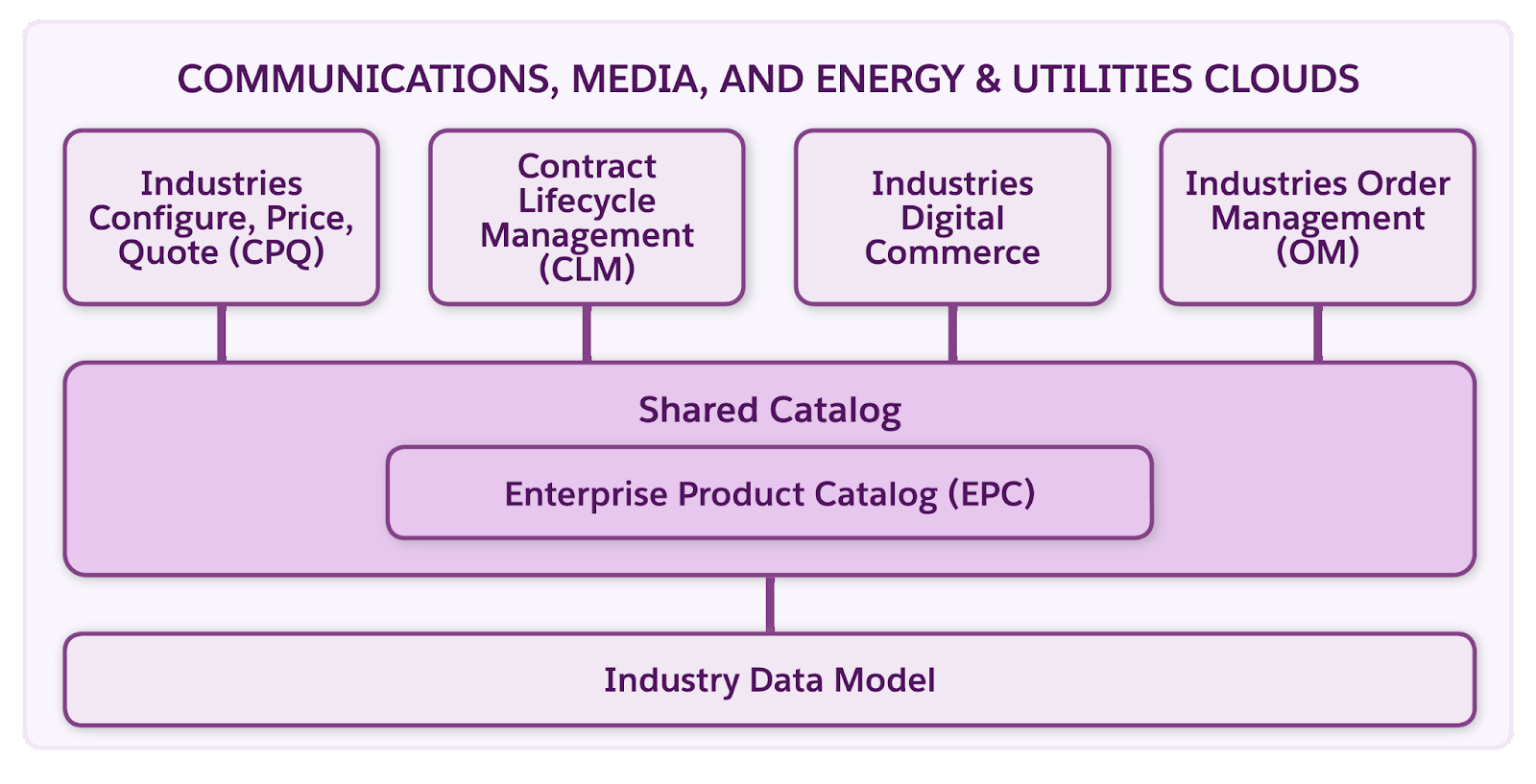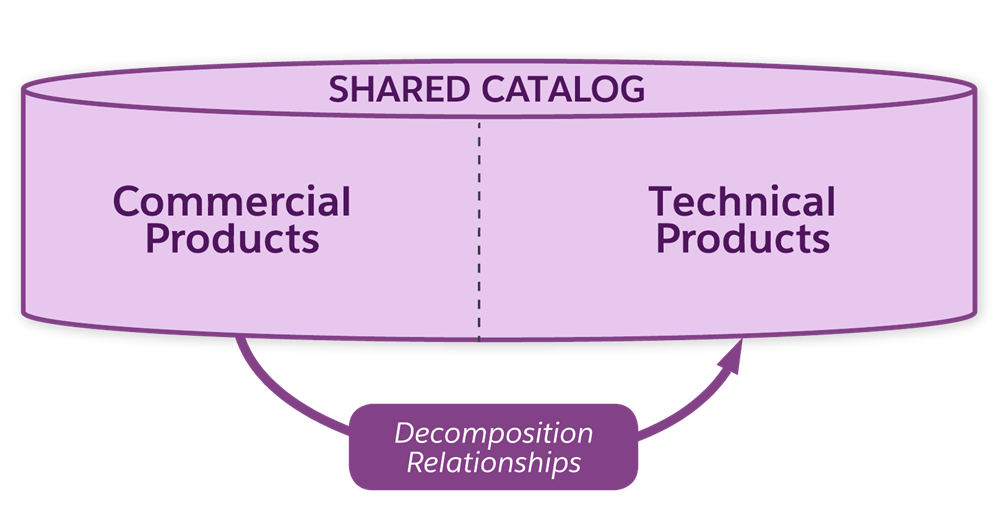Discover Industries EPC
Learning Objectives
After completing this unit, you’ll be able to:
- Summarize the purpose and benefits of EPC.
- Differentiate Shared Catalog and EPC.
- Describe how different industries use EPC.
Enterprise Product Catalog
EPC is a centralized platform for efficiently creating, managing, and delivering your company’s products. With EPC, you can design, launch, and manage product data and end-to-end processes to drive business-to-business (B2B) and business-to-consumer (B2C) sales, configure-price-quote, ordering, and fulfillment functions. From the early beginnings of a product’s inception to the final delivery to your customer, EPC is the go-to workspace for all product and pricing endeavors.
A Single Source of Truth
At the heart of EPC is Shared Catalog: a powerful, flexible tool for creating, modifying, and maintaining products and prices across your organization. Shared Catalog comes out of the box with Industries CPQ, while EPC requires a separate license.
Shared Catalog is based on the Industry Data Model and serves as a dependable foundation for all products, services, and resources used by Industries Communications, Media, and Energy & Utilities Cloud applications. The apps include CPQ, Digital Commerce (DC), Contract Lifecycle Management (CLM), and Industries Order Management (OM).

Shared Catalog includes the following features.
-
Product Designer to create and manage all aspects of product offerings. It gives you reusable, cross-functional components, like attributes, picklists, object types, products, and offers.
-
Pricing Designer to create reusable pricing components like price books, price lists, pricing variables, promotions, discounts, charges, time plans, time policies, and more.
-
Rules frameworks to define business rules for availability, eligibility, configuration, and validation, and pricing rules to govern how products are sold and which customers have access to certain offers.
-
Tracking tools to manage projects and generate reports, for example, to keep tabs on catalog data.
Shared Catalog is a unified platform for both commercial products and technical products. Commercial products are the customer-facing assets available for purchase. Technical products are the underlying back-end components that order management uses to fulfill orders of commercial products through a process known as orchestration.
With an additional license, you have access to Enterprise Product Catalog (EPC), which gives you the full capabilities of Shared Catalog. With EPC, you can employ all the catalog features, plus you have more control over catalog entity versioning and lifecycle management.
You can set up your product catalog hierarchy to match your current business standards, or configure it to align with data models that best fit your industry, such as the TM Forum Information Framework (SID).
A Good System
“A good system shortens the road to the goal.” — Orison S. Marden
EPC is the industry-leading product-management solution for three main reasons: It’s fast, flexible, and centralized.
Fast
EPC reduces the time needed for initial product and pricing setup, the sales cycle, and order processing. With the reusable, cross-functional components of EPC, you can deliver products and services to the market faster, stay ahead of the competition, and optimize customer loyalty.
Create product attributes, pricing components, and other standalone building blocks once, and then reuse them many times across the catalog. This modularity means you can quickly design, build, test, and launch new products while reducing the overall volume of data in your catalog. With fewer data points to manage, EPC also reduces operational and delivery costs and simplifies business processes.
Flexible
As your market and business needs evolve, you can adapt Shared Catalog in several ways to prioritize business needs.
-
Pricing: Configure simple or complex price structures for your product line. For instance, set the price of a product to automatically decrease when included as part of a specific bundle and increase when customers order it individually.
-
Price lists: Attract new business by employing price lists that are specific to a particular channel, market, or customer. Also share underlying product components across different market categories.
-
Discounts: Assign attribute-based, tiered, threshold, or flat rating discounts to encourage upselling and cross-selling during negotiation.
-
Promotions: Boost sales by setting up limited-time promotions with special pricing for select products.
Centralized
Gone are the days of working in disparate, legacy systems. Because EPC is a unified, cloud-based solution, business and IT users can collaborate in real-time to build a single source of truth for all their products and services.
Use EPC to manage both commercial and technical products. Let’s find out more about the difference.
-
Commercial products are the customer-facing assets that are available for purchase and are managed by sales and marketing teams. A smartphone is an example of a commercial product sold to customers.
-
Technical products are the underlying back-end components that order management engineers and delivery teams use to fulfill orders for commercial products. Technical products associated with a smartphone often include a SIM card and an activation service.
You map these two entity types to one another so that Order Management can decompose the order into the associated technical products during orchestration.

The unified architecture of commercial and technical products allows you to share resources and common tools between marketing and delivery teams. The resulting collaboration eliminates silos in the organization and significantly reduces errors in the selling process.
You can set up the architecture of your catalog to match your current business standards, or configure it to align with data models that best fit your industry. For instance, EPC supports TM Forum’s Information Framework (SID), which is commonly used in the communications industry. Once you’ve established your data standards, you can ensure consistency across all your product definitions.
EPC Roles
Here are some common roles who use EPC.
-
Product designers build out catalog offerings by forging new products and associated metadata. They establish relationships between products, create product bundles, and assign prices and rules to control how offers are presented to customers.
-
Pricing designers and pricing managers use EPC to maintain and contribute to company price books and price lists. They also configure promotions, discounts, and pricing schemes to drive sales and compete across different markets.
-
Product catalog administrators set up and maintain EPC and its information structure. They migrate data, run administrative jobs, manage user permissions, and perform other background tasks to ensure catalog information is up to date and follows company guidelines.
Of course, product and pricing teams may differ from company to company.
EPC in the Real World
Let’s look at how different industries use EPC to roll out products and services to stay competitive in their unique markets.
Interactivity: Click to Reveal
No matter what industry you’re in, you can use EPC to creatively market, sell, and deliver your products, services, and resources.
A Fresh Start
Devi couldn’t be more thrilled to retire his dusty old spreadsheets and begin anew by building his catalog with this fast, flexible, cohesive, and consistent solution. Now that we’ve explored why EPC is the industry-leading solution for managing products, let’s dig deeper into the features.